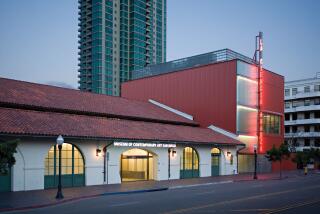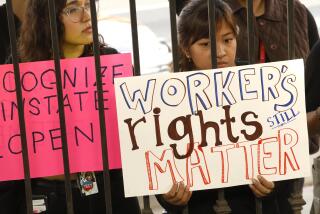Mexico museums exhibit stress
- Share via
MEXICO CITY — California-based multimedia artist Mike Rogers was finishing his photographs for an exhibition in Mexico City when he got an urgent e-mail from the curator: The show had been called off. The capital’s contemporary art museums were broke and shutting down.
The message was exaggerated. Museums are not closing -- yet. But across Mexico City’s eclectic art world, museum directors, curators, artists and performers are bracing for a round of recession-triggered budget cuts that could prove devastating.
“I am very worried. Everyone is,” said Sofia Hernandez Chong Cuy, the young, dynamic director of Mexico’s famous Tamayo Museum of Contemporary Art who, like many of her colleagues, is scrambling to find ways to pinch pesos without hurting the art.
Although museums from Los Angeles to London are feeling the crunch from the global economic meltdown, the crisis is particularly acute in a country that prides itself on a unique artistic tradition, where access to “culture” is enshrined in the constitution.
For artists left out in the cold like Rogers, there is disappointment. He and creative partner Dustin Ericksen were originally scheduled to show their collection of hundreds of glasses and other drinking vessels used by famous and aspiring artists, a project years in the making. The exhibit at the Carrillo Gil Art Museum, slated for Aug. 26 to Nov. 16, was then scaled back to photographs of the project, Rogers said. And then, he was told, it was canceled altogether.
“The story is so sad,” Rogers, 51, said by telephone from Long Beach. “Everyone here is a victim, from the artists to museum-goers to the museums.”
(Shortly after The Times made inquiries of the museum, Rogers received another e-mail from the curator, saying that the show might go on after all, limited to a slide show.)
Museums in Mexico were already reeling from a sharp decline in visitors after spring’s deadly swine flu epidemic. To fight the spread of the virus, the government ordered public venues, including museums, to temporarily close their doors, and the tourism industry all but collapsed.
And just when many of the galleries that display everything from ancient statues to Frida Kahlo to avant-garde videos were beginning to recover, Mexico announced emergency plans to cut billions of dollars from the federal budget. That is going to hurt a wide range of programs and institutions, including schools, road and other infrastructure construction, state and municipal governments, and cultural projects.
Many museums in Mexico rely heavily on government money, part of what is seen here as a legacy of the Mexican Revolution, whose goal to modernize the country included building up education and the arts. With the state taking such an active role, the tradition of philanthropic support for museums lagged. And where private donors do figure, their contributions have also diminished in hard times.
Authorities have still not said how deep the budget cuts will be, leaving everyone on edge and fueling a tempest of rumors and demands for transparency because of suspicions that some measures may be hidden. Art aficionados, actors, writers and dancers are circulating petitions and holding town hall meetings to protest what they call “brutal cutbacks.”
They fear layoffs, cancellations of exhibits and blackout days at major museums.
“It’s been a culture shock,” said the Mexican-born, U.S.-trained Hernandez, who took the Tamayo post in June. “The key is to negotiate, negotiate.”
Hernandez and several other museum and gallery officials interviewed said that so far they have tightened their institutional belts in ways that the public shouldn’t notice. Some have postponed exhibits, cut back on overtime, suspended publications or dropped nonessential personnel.
“I wanted to streamline things like promotions anyway, and this makes me take those decisions a little earlier,” Hernandez said. “I don’t plan to cut any programs, but I could reschedule some to stretch it out a bit -- a bit.”
The Tamayo, built in 1981 to house the collections of renowned Mexican painter Rufino Tamayo, is better positioned than most because Tamayo formed a foundation that supports the museum, accounting for about one-third of the operating budget, Hernandez said.
Carlos Phillips Olmedo, director of three museums dedicated to Kahlo and her husband, the legendary muralist Diego Rivera, said he scrapped two shows scheduled for the summer, laid off a number of part-time docents and will probably postpone remodeling projects. But none of this, he said, will impair the daily operation of the museums, nor will it force them to reduce operating hours.
“I don’t want to say that we have not been affected, we have, but it is not a disaster,” Phillips said. “We are not in articulo mortis,” or at the point of death.
Phillips’ institutions -- the Dolores Olmedo Patino Museum, the Frida Kahlo Blue House and the Diego Rivera Anahuacalli Museum -- are privately owned and consequently not as dependent on government money. But Phillips said attendance plummeted by 90% during the flu crisis, recovering finally last month.
Flu aside, the global financial crisis has hit Mexico particularly hard, in part because its economy is so intertwined with that of the United States. Revenue from all major sources of income, including manufacturing exports, oil, remittances and tourism, has dropped precipitously. Finance Minister Agustin Carstens, warning this month of the potential for Mexico’s worst recession in 30 years, predicted a $23-billion deficit, and the economy is expected to contract by more than 7%. Carstens ordered broad cuts and said new taxes may have to be levied.
Government culture officials are seeking to downplay the impact that the cuts will have on museums, which remain among Mexico’s most important tourist attractions.
“We have to protect our mission to promote art, and I am very optimistic we will be able to move forward,” said Alejandra Pena, deputy general director of artistic patrimony at the National Fine Arts Institute, the government entity that oversees 18 state-financed museums, including the Tamayo and the Carrillo Gil.
At the Carrillo Gil, which specializes in contemporary art, officials also minimized the impact.
“We’re working very hard to see through all of our exhibitions,” said spokesman Adrian Gonzalez.
Critics say the government undervalues the role of art, culture and theater in Mexican society and in economic development, and is all too quick to pull the plug when times get tough.
“The authorities always try to resolve these problems by eliminating resources for education and culture, and so the country cannot make progress,” said Rossana Filomarino, one of Mexico’s foremost performers and choreographers of modern dance. “They do not understand that access to cultural production is as necessary to Mexicans as the tortilla.”
--
Deborah Bonello of The Times’ Mexico City Bureau contributed to this report.
More to Read
The biggest entertainment stories
Get our big stories about Hollywood, film, television, music, arts, culture and more right in your inbox as soon as they publish.
You may occasionally receive promotional content from the Los Angeles Times.










